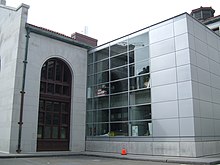Shot peening

Shot peening is a process used to produce a compressive residual stress layer and modify mechanical properties of metals. It entails impacting a surface with shot (round metallic, glass or ceramic particles) with force sufficient to create plastic deformation. It is similar to sandblasting, except that it operates by the mechanism of plasticity rather than abrasion: each particle functions as a ball-peen hammer. In practice, this means that less material is removed by the process, and less dust created.
Peening a surface spreads it plastically, causing changes in the mechanical properties of the surface. Shot peening is often called for in aircraft repairs to relieve tensile stresses built up in the grinding process and replace them with beneficial compressive stresses. Depending on the part geometry, part material, shot material, shot quality, shot intensity, shot coverage, shot peening can increase fatigue life from 0%-1000%.
Plastic deformation induces a residual compressive stress in a peened surface, along with tensile stress in the interior. Surface compressive stresses confer resistance to metal fatigue and to some forms of stress corrosion. The tensile stresses deep in the part are not as problematic as tensile stresses on the surface because cracks are less likely to start in the interior.
Shot peening may be used for cosmetic effect. The surface roughness resulting from the overlapping dimples causes light to scatter upon reflection. Because peening typically produces larger surface features than sand-blasting, the resulting effect is more pronounced.
Shot peening was originally developed by John Almen when he was working for Buick Motor Division of General Motors Corporation[when?]. In an attempt to salvage some rusty valve springs by shot blasting them, it was found during performance tests that they actually lasted much longer then the standard valve spring. After some developement of the process, an analog was needed to measure the effects of shot peening. He noticed that shot blasting, as it was called back when he was working, made the side of the sheet metal that was exposed begin to bend and stretch. John Almen also created the Almen strip to measure the comprehensive stresses in the strip created by the ball peening operation. One can obtain what is referred to as the "Intensity of the Blast Stream" by measuring the deformation on the Almen strip that is in the shot peening operation. As the strip reaches a 10% deformation, the Almen strip is then hit with the same intensity for twice the amount of time. If the strip deforms another 10%, then you have the, "Intensity of the Blast Stream."
A study done through the SAE Fatigue Design and Evaluation Committee showed what shot peening can do for welds compared to welds that didn't have this operation done. The study claimed that the regular welds would fail after 250,000 cycles when welds that had been shot peened would fail after 2.5 million cycles, and outside the weld area. This is part of the reason that shot peening is a popular operation with aerospace parts. However, the beneficial prestresses can anneal out at higher temperatures.
See also
- Almen strip
- Autofrettage, which produces compressive residual stresses in pressure vessels.
- Case hardening
- Differential hardening
- Peening
- Abrasive blasting
